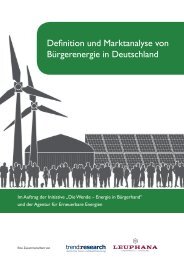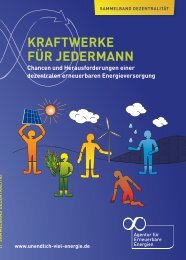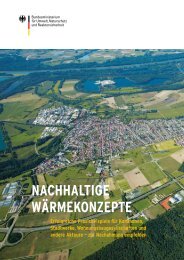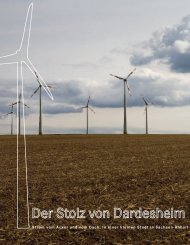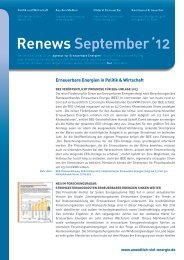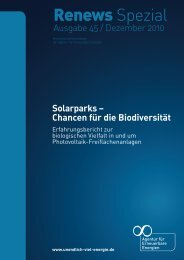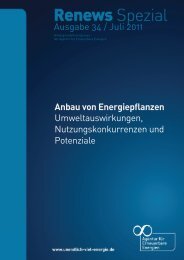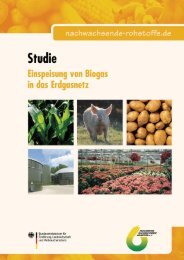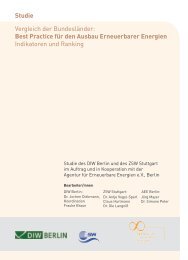Solar parks - Agentur für Erneuerbare Energien
Solar parks - Agentur für Erneuerbare Energien
Solar parks - Agentur für Erneuerbare Energien
You also want an ePaper? Increase the reach of your titles
YUMPU automatically turns print PDFs into web optimized ePapers that Google loves.
Renews Special Best practice recommendations Issue 45 | p 30 p 31 | Issue 45 Renews Special <strong>Solar</strong> <strong>parks</strong> – Opportunities for Biodiversity<br />
The official approval for the 40 MW Waldpolenz solar park constructed on 110 hectares on the former<br />
airfield near Brandis in Saxony in 2007 stipulated a nine-year monitoring programme that began before<br />
construction started. The monitoring data is used as a basis for checking and modifying the specified<br />
compensatory measures, and for documenting any changes to the monitored bird and grasshopper<br />
populations as a result of the solar plant. The research conducted so far shows no relevant changes to<br />
the species groups being monitored.<br />
b. Environmental site conservation and maintenance<br />
Because of their location, the land inside solar <strong>parks</strong> often consists of open habitats with no trees<br />
or shrubs. The regular, extensive maintenance required for these open grassland areas can create<br />
valuable, species-rich habitats. A number of animal and plant species depend on regular maintenance<br />
of their habitats if they are to survive.<br />
To conserve the open spaces, grassland surrounding the solar plants has to be mown at regular intervals. (Photo: BELECTRIC)<br />
At the Fürth-Atzenhof solar park, the grassland is maintained and conserved by a shepherd, who grazes<br />
sheep on the site twice a year. Without these measures, shrubs and trees would appear all over the site,<br />
and the sun-loving plants would disappear. The 1 hectare solar plant was built in 2003 on the southern<br />
slope of the former municipal landfill site. Investigations in 2009 revealed an astonishing diversity of<br />
plant species. A total of 254 types of ferns and flowering plants and 30 types of moss were found. Of the<br />
plants found on the hill, 23 species are included on red lists at regional, national or international level.<br />
Sheep grazing is an environmentally friendly way of keeping sites free from shrubs and trees, as seen here at the Atzenhof solar park. (Photo: Stadt Fürth)<br />
Whereas mowing once or twice a year is sufficient to conserve the local species diversity at the Salmdorf<br />
solar park, the Lieberose solar park requires more elaborate maintenance. The regular maintenance<br />
and conservation measures carried out during the construction and operation of the solar plant ensure<br />
the conservation of high nature value moorland and open grassland habitats that had been seriously at<br />
risk of being taken over by woodland. The measures are carried out between the solar modules and on<br />
undeveloped land within the site and on outlying compensation areas. The measures include extensive<br />
maintenance of the areas between and underneath the modules and the regular removal of young trees<br />
and shrubs. This conserves the habitat for rare bird species that rely on it, such as the hoopoe.<br />
The open and semi-open character of the site at the Waldpolenz solar park and its structural diversity,<br />
which was found during investigations to be very valuable particularly for birds like the whinchat, would<br />
have been lost without the maintenance measures and extensive grazing. The measures are primarily<br />
designed to conserve the vegetation that has developed on the former airfield. As well as conserving<br />
the areas that are important for flora and fauna, low-value areas were improved in terms of nature<br />
conservation through extensive maintenance measures and selective planting activities. The 121 hectare<br />
grassland area surrounding the solar park is maintained to conserve the sparse grassland structures<br />
by means of sheep grazing on the compensation areas and by mowing twice a year and removing the<br />
cuttings.



